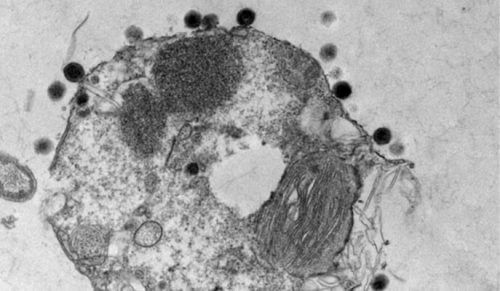The institute's scientists have developed a tiny aquarium, which allows studying the effects of climate change on microscopic processes in living corals. These days the system is adapted to monitor the food and carbon cycles of corals.

All living things - from unicellular algae to the human body - are exposed to viral attack. Dr. Assaf Vardi And the members of his group, in the Department of Plant and Environmental Sciences, recently revealed a new mechanism by which marine algae become infected with viruses. their research findings, that were published recently In the scientific journal "Records of the American Academy of Sciences" (PNAS), may yield new insights regarding the algal bloom cycles in the ocean and the evolutionary "arms race" taking place between the virus and its host.
Emiliania huxleyi It is one of the most common types of algae in the ocean. It creates blooms so large that they can be tracked by satellites. They spread over thousands of square kilometers, then quickly collapse in a matter of days. Dr. Verdi and his group members have already shown, in a previous study, that viruses can spread and eliminate an entire rash within a week. Like all viruses, these also invade the host's cells, and use the cell's materials to reproduce themselves. However, the giant viruses that wipe out algal blooms are no ordinary viruses; They have a large genome that contains genes that have not been seen in other viruses so far, and they are experts in eliminating algae species Emiliania huxleyi.
The research was led by Dr. Vardi's research group, led by postdoctoral researcher Dr. Carmit Ziv, in collaboration with postdoctoral researcher Dr. Sergey Malitsky - who is conducting his research in the groups of Dr. Vardi and Prof. Assaf Aharoni from the Institute Weizmann Institute of Science - and with Dr. Thorsten Hornmann and Dr. Ala Othman from the University of Zurich, Switzerland. The group investigated the metabolic basis of the virus's ability to attack the algae, and found in the virus's genome a cluster of genes encoding a metabolic pathway that is almost identical to that of the algae. The pathway codes for a group of enzymes that are responsible for the synthesis of a fatty molecule (lipid) called "sphingolipid". This molecule is found in almost all living cells - from algae cells to human cells - and is responsible for the structure of the cell membrane and for sending signals that determine the fate of the cell. The viruses take over this molecule, and use it to build membranes that are at the base of their structure.

The scientists followed the production process of the viral versions of those lipid molecules, and found that they are produced in large quantities during a virus invasion of an algal cell. The research group later discovered that the presence of these molecules is necessary for the viral infection process: the virus rewires the host body's lipid molecule production mechanism, forcing it to use the viral enzyme to produce the molecules it needs. This is how these molecules serve as the basis for new viruses. The viral molecules also function as signals to the host cell, and in many cases these signals cause cellular suicide (apoptosis).
"Our findings reveal unique insights into the 'arms race' conducted by the virus and the host cell," says Dr. Vardi. "The virus that attacks the algae has evolved and been optimized so that it is able to participate in the lipid production process. In other words, his survival strategy is based on 'metabolic engineering'." This arms race can be fatal for both the cell and the virus, thus affecting the cycles of bloom and collapse of algae in the ocean. The scientists hypothesize that an increase in the levels of viral lipids may serve as an initial sign that a viral infection has begun to spread in the algae. This hypothesis may help quantify the effect of marine viruses on the carbon cycle and the marine food web that is based on these algae.
This is the first time it has been discovered that a metabolic pathway encoded in the viral genome regulates the lipid production of the host body, as part of viral infection. But since the lipid molecules are essential for both cells and viruses, the scientists hypothesize that it is possible that other viruses - including those that cause diseases in humans - have developed similar genetic means for infecting cells, through manipulation of the host body's lipid production mechanism.
